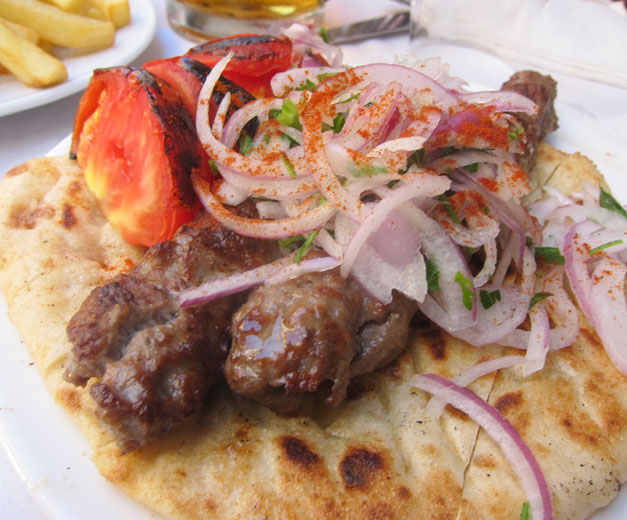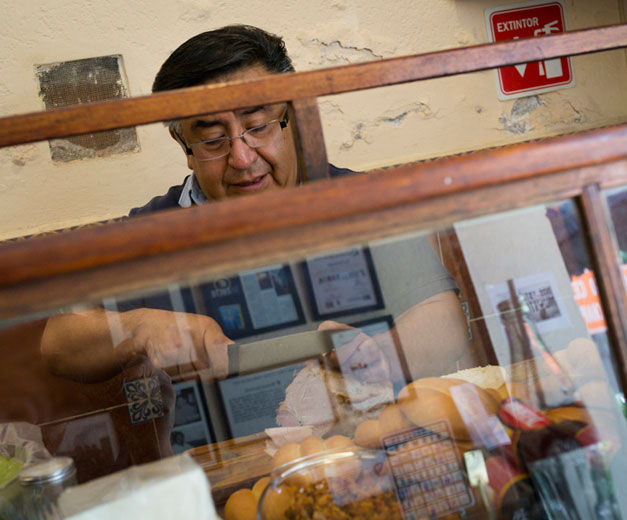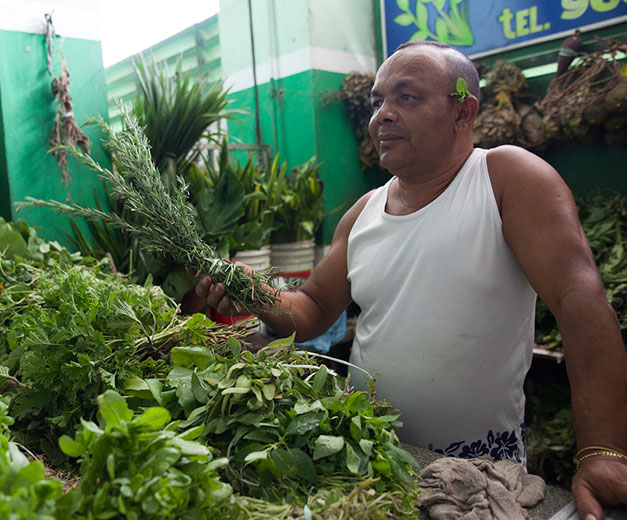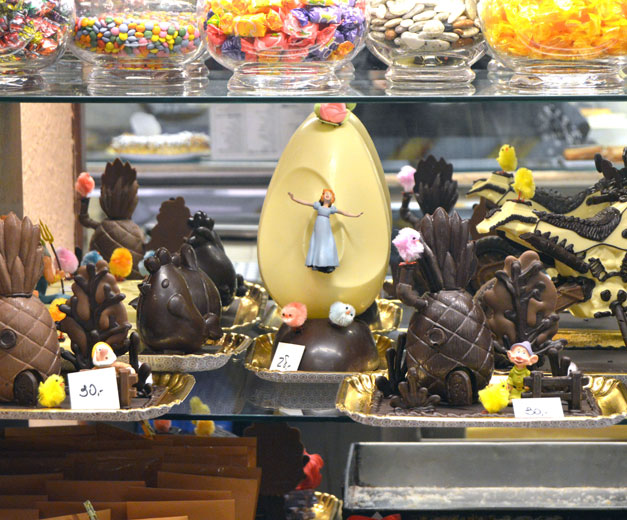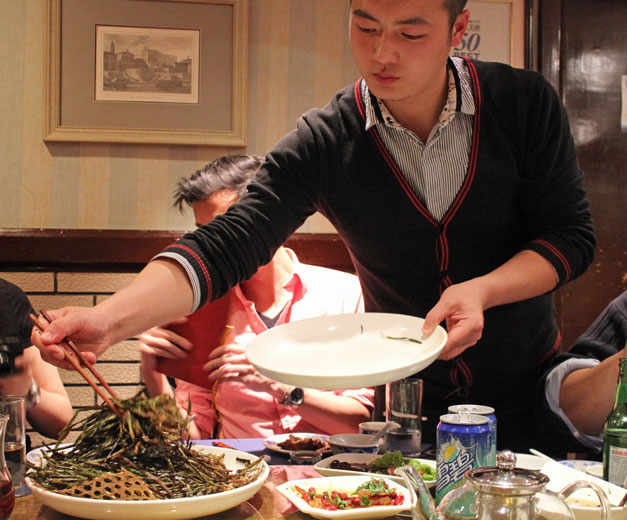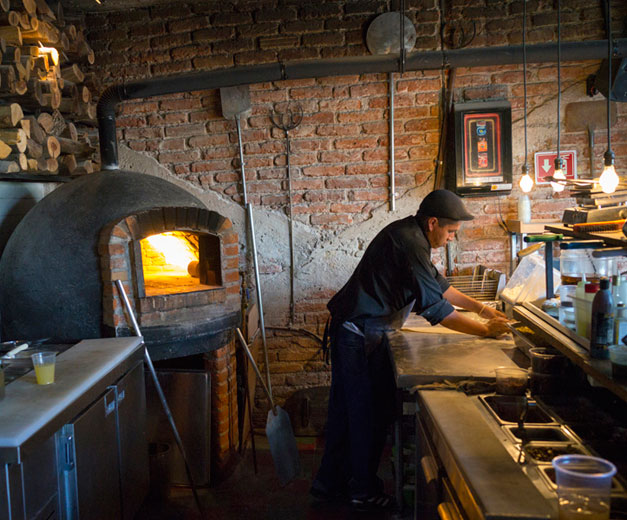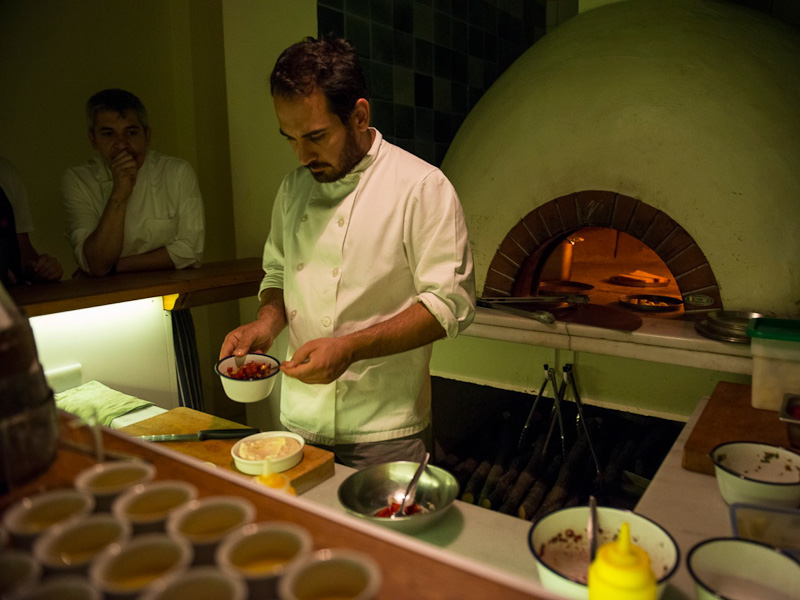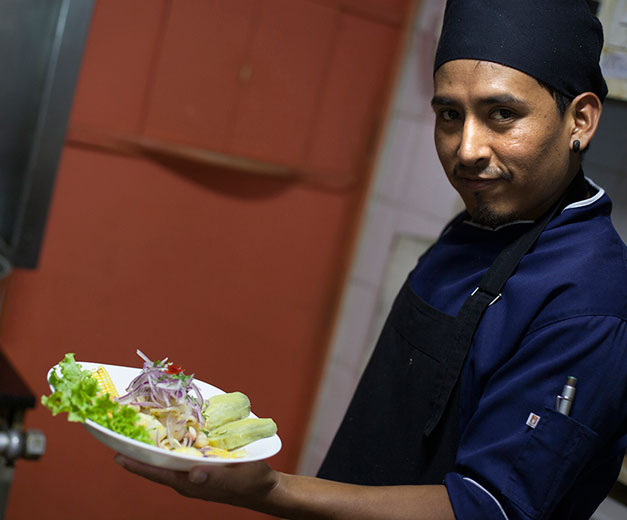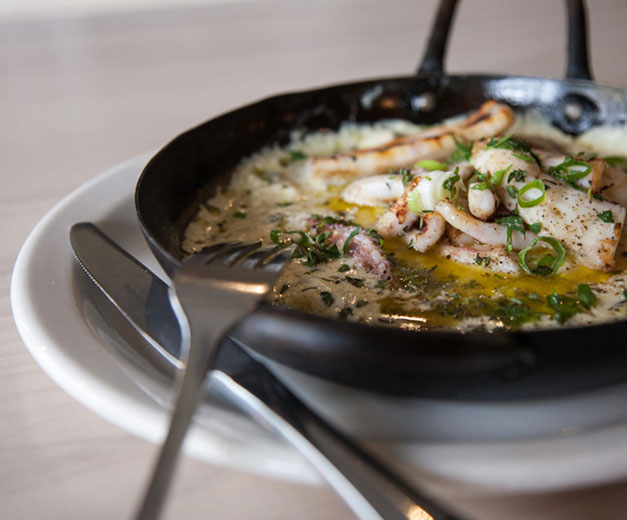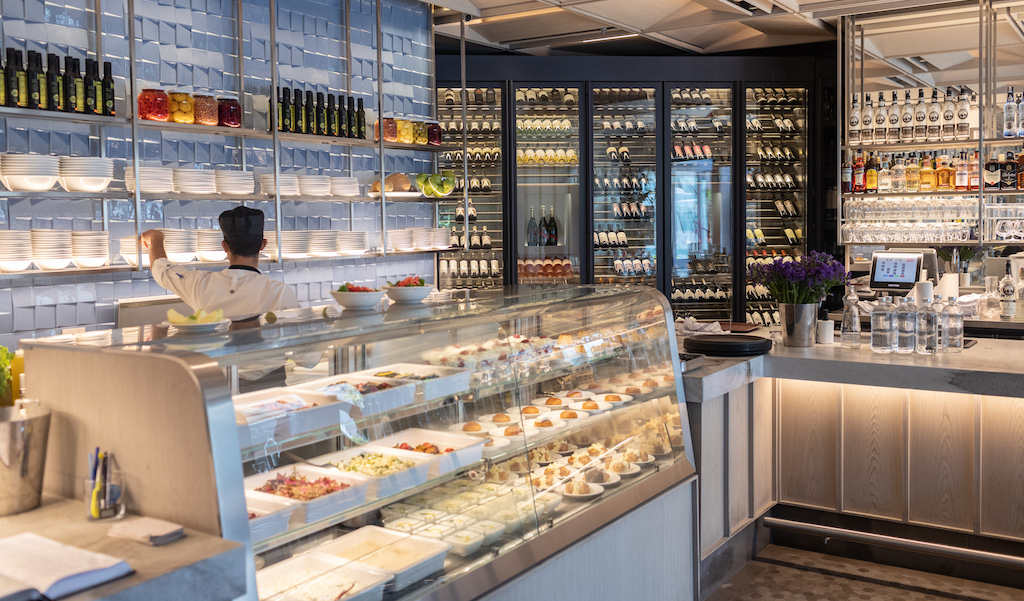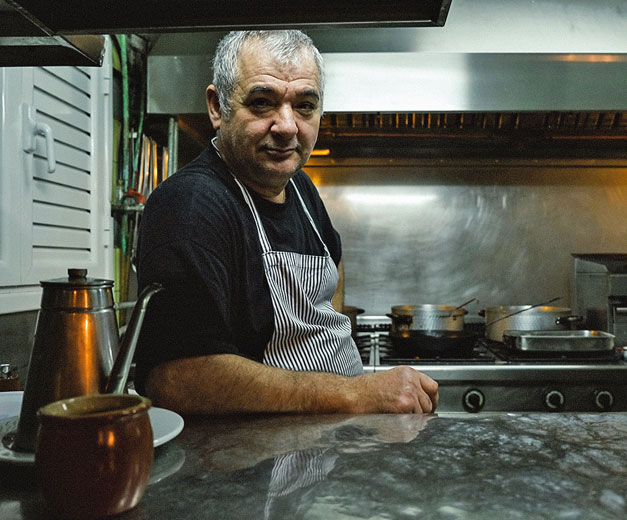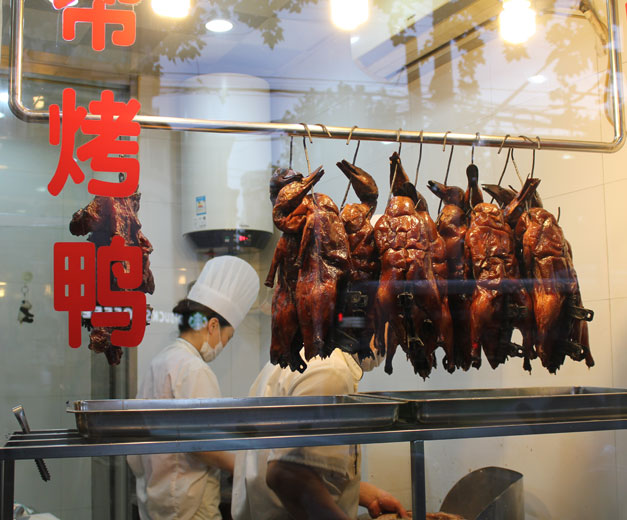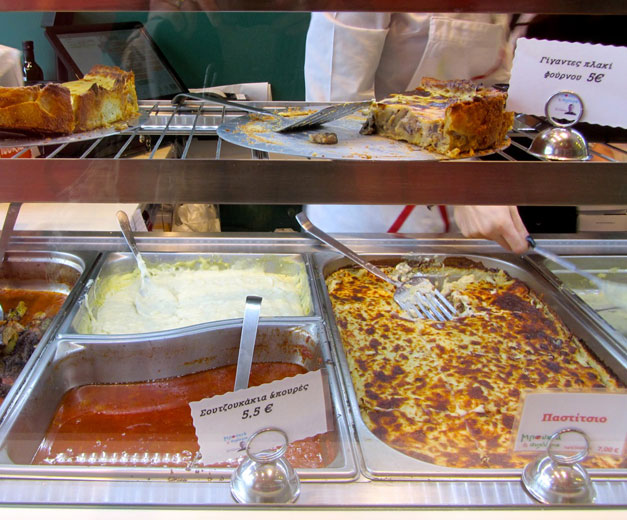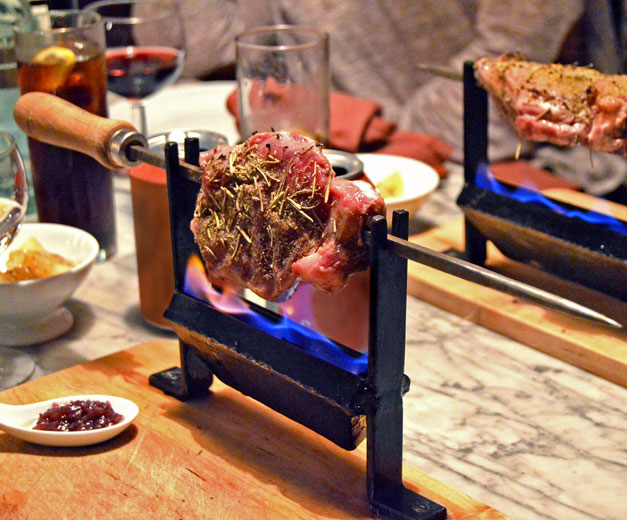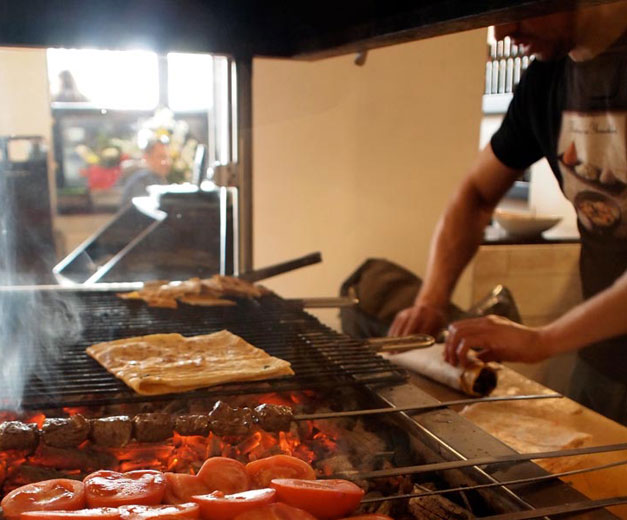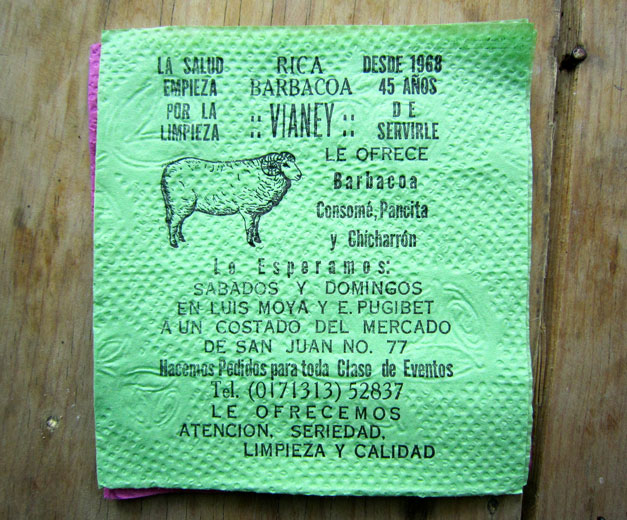We can't find the internet
Attempting to reconnect
Something went wrong!
Hang in there while we get back on track
Search results for
Istanbul
Spring (Food) Break 2014: Istanbul
With all of the anticipation of local elections in March, the scandalous graft-laden tapes leaked via social media, the communication fog brought on by the ban of Twitter and YouTube and the subsequent call for a vote recount in many cities, this city's stomach had good reason to be distracted. But one cannot survive on a diet of daily news alone. In case you all forgot, Spring is here.
Read moreAthens
First Stop: Peter Minakis's Athens
Editor’s note: For our First Stop series, we asked Toronto blogger Peter Minakis, who writes about Greek cooking and dining at Kalofagas, where he heads first for food when he arrives in Athens. Minakis is the author of The Everything Mediterranean Cookbook and his latest book, The Big Book of Mediterranean Recipes, is due out by the end of April.
Read moreMexico City
Best Thing Since Sliced Bread: Mexico City's Top 5 Torterías
Taquerías are probably the most common kind of eatery in Mexico City, but torterías, purveyors of tortas, the generously filled sandwiches that come on bolillo rolls or the smaller teleras, are not far behind. From stalls at subway station exits to restaurants that have been in business close to a century, torterías are a fixture in the city landscape. Here are five of our favorites, in no particular order:
Read moreRio
Mercadão de Madureira: From Live Animals to Dead Souls
For the carioca in need of grains in bulk, cheap party decorations, live animals and herbs for the ritual baths practiced in Afro-Brazilian faiths, the Mercadão de Madureira offers one-stop shopping. Madureira is a good two-hour bus ride from tourist-zone Ipanema and is tucked behind hills far from the ocean breeze, which means the neighborhood heats up even more than already steamy Rio. In the heart of Rio’s working-class north zone, the Mercadão is where cariocas who count every real go to comparison-shop and haggle for the best deals in the city limits. Remember that the minimum wage in Rio is less than 800 reais (about US$330) per month, and a middle-class family is defined as earning above US$450 per month. That means the 100-real meals of Ipanema are hardly palatable for the so-called “new middle class.” Despite the cheery BRIC emerging-economy narrative and the olho grande (“big eye,” or greed) of investors looking for a new consumer market, this sector of Brazilian society can be better understood as the working poor.
Read moreIstanbul
Erzincan Tandır Ekmeği: Village Loaves for City Folks
In the Kurtuluş district of Istanbul, we’ve lately been exploring links to older, nearly lost Istanbul culinary traditions. Spending time in the sweetshops, milk bars and şarküteri of this district, we’ve seen a glimmer, if faded, of the “Old Istanbul” that people remember from the 1950s and '60s, when the city’s historic minorities – Greeks, Armenians and Jews – played a prominent role in the culinary scene of the city. It’s a complex and endlessly fascinating subject, one that never fails to spark our curiosity. And then we were distracted by the smell of fresh bread. Fresh lavaş, to be more specific, being hoisted out of a fiery hole in the floor on a blackened hook by the sturdy Gül Hanım.
Read moreShanghai
Zhaojialou Water Town: Snack Street Field Trip
For visitors looking to get beyond Shanghai’s urban core, among the main attractions are the plentiful water towns that ring the outer suburbs in just about every direction. The name refers to the bygone reliance of these towns on water for irrigation and transport, especially in the form of canals. Billed as ancient villages, the popular destinations tend to be packed with visitors, with traditional foods as the main draw – perhaps due in part to the lack of other activities on offer.
Read moreBarcelona
Museu de la Xocolata: Chocolate City
In the weeks leading up to Easter, Barcelona looks like an extension of Willy Wonka’s factory-fun house: chocolate castles, houses, animals, cars, motorbikes and even cartoon characters and fútbol celebrities fashioned out of cacao populate the city’s traditional patisseries. Catalonian confectioners expect to sell some 600,000 chocolate sculptures decorated with yellow chicks, chocolate eggs and cakes studded with hard-boiled eggs and colored feathers this year. The last are known as monas, and godparents traditionally give these to their godchildren throughout Catalonia and other parts of Spain to mark the holiday.
Read moreShanghai
Old Jesse: The Inside Track to a Guidebook Favorite
Ask a Shanghainese person for the best běnbāng, or local, restaurant in town, and you’ll probably be pointed toward Old Jesse. The doyenne of haipai cuisine, this ramshackle restaurant is the darling of the guidebook industry, with mentions in publications from Travel + Leisure to Lonely Planet, but that doesn’t mean that it’s foreigner-friendly. In fact, when LP first published their listing back in 2008, Old Jesse stopped taking reservations in English for some time, just to spite the hordes of tourists vying for a seat in their tiny former French Concession establishment. Even now, the lingua franca in the packed dining room is Shanghainese, and it’s still not uncommon for a laowai’s reservations to disappear if he or she is just a few minutes late, or for foreigners to have to watch hungrily as the dishes they ordered come out to tables manned by locals first, even though said locals were seated long after them.
Read moreAthens
Greek Food Idioms: Turning Sour Grapes into Honey
With its rich, profound history – its roots lie in epics and at the foundation of modern civilization, after all – the Greek language is ripe for and with metaphor, particularly of the food-related variety. Folk sayings and proverbs have a prominent place in colloquial language and everyday life, and they are at turns humorous, instructive and ironic. And sometimes they are all three at once.
Read moreMexico City
A Slice of the Action: Pizza in Mexico City
Mexico City is indisputably one of the world’s great eating capitals, and one of its main draws is the astonishing regional diversity in the Mexican cuisines that are available here. But sometimes, the only thing that’ll hit the spot is a slice of pizza. Fortunately, D.F.’s got you covered there, too. There are hundreds of pizzerias to choose from, from big chains to small family-run establishments, but these are our three favorites.
Read moreRio
Back to the Source: Rio's Top 5 Coffee Spots
Perhaps coffee is underappreciated in Rio because it’s so plentiful. Brazil is the world’s largest producer of coffee, but both the selection and the presentation of the stuff you’ll find in Rio is hardly what a gringo dreams of in the capital country of café. Coffees here are cafezinhos, small, potent, highly sugary and with no milk. A cafezinho is taken standing up at a lanchonete (snack bar) or on a work break in the office in tiny medicine cups filled from an unseemly plastic cylinder. When Brazilians have seen the size of our morning coffee, many have expressed a concern that we could hurt ourselves with such a large quantity. (It’s just a coffee cup.)
Read moreBarcelona
Bulk Food: Culinary Inspiration, by the Kilo
Early on in Jean-Pierre Jeunet’s 2001 film Amélie, the title character plunges her hand into a big sack of lentils, relishing the sensation of them slipping through her fingers, a look of pure pleasure on her face. That kind of behavior is verboten in shops that sell dry goods by weight, but buying groceries in bulk has its own inherent pleasures (and you can run your fingers through your purchases once you’re back at home). Just as with bulk wine, buying food in bulk is making a comeback in Barcelona. Not only does this practice yield less packaging waste, but in our minds, it also makes hunting for great ingredients all the more enjoyable.
Read moreIstanbul
First Stop: Ana Sortun's Istanbul
Editor’s note: In the inaugural post of our new recurring feature, First Stop, we ask Chef Ana Sortun of the much-beloved restaurant Oleana and bakery Sofra in Cambridge, Massachusetts, where she heads first for food when she arrives in Istanbul. Sortun received the James Beard Foundation’s award for “Best Chef Northeast” in 2005 and wrote the cookbook Spice: Flavors of the Eastern Mediterranean. Her newest restaurant, Sarma, opened at the end of 2013 in Somerville, Massachusetts.
Read moreShanghai
Move Over, Tea: Shanghai's Top 5 Coffee Shops and Roasters
China is increasingly becoming a nation of coffee drinkers, a trend that is quietly percolating out beyond the confines of cosmopolitan Shanghai and Beijing. As more and more tea terraces are converted to profitable coffee plantations in the country’s mountainous southwest regions, and with the number of Costa Coffee and Starbucks locations still on the upswing, it’s never been easier to find a decent cup of joe.
Read moreRio
Intihuasi: Andean High
After three decades in Brazil, Margarita Sayan Pinto still speaks a charming, peppery portunhol – the Spanglish-like mix of Portuguese and Spanish – that she seems in no hurry to rid herself of. The chef remembers an interaction she had with a local taxi driver when asked to describe why she opened Rio’s first Peruvian restaurant nine years ago. "Peru?" the driver said. "That’s the only country in South America that doesn’t border Brazil." (Peru indeed has a 1,860-mile border with Brazil. Ecuador and Chile are the only South American nations that do not touch Brazil.)
Read moreElsewhere
Diaspora Dining: Greek Flavors Down Under
Greeks have been gravitating towards Melbourne, nestled in the southeastern corner of Australia, ever since the gold rush of the 1850s. The Greek Orthodox Community was formally founded in 1897, and the first Greek language newspaper, Australis, was issued in 1913. But it was in the 1950s and '60s, as the consequences of the civil war continued to be felt in Greece, that they really immigrated in earnest, coming in the thousands. Today Melbourne boasts the largest population of Greeks outside of mainland Greece, and the world’s third-largest Greek-speaking population after Athens and Thessaloniki.
Read moreIstanbul
Trileçe: The Balkan Cake of Mystery
It’s hard to imagine Istanbul without its pastane windows stacked high with trays of ivory-colored flaky mille-feuille and coolers lined with row after row of chocolate-topped éclairs. And of course, the sweets scene in Istanbul would not be complete without the much-loved profiterole. Generations of İstanbullu have taken pleasure in these French exotics, but at some point they became part of the local dessert canon, complete with their new Turkish ID, milföy and ekler. Their origins, their journey to Istanbul, if still relevant, have been more or less wiped clean from the memory of the city.
Read moreAthens
Rise and Dine: Athens' Top 5 Grab-and-Go Breakfasts Downtown
We know that there’s a trend away from gluten and carbs these days, and all we have to say to that is: more for us! In Athens, bread and pies still form the foundation, if the not the substance, of many a meal – breakfast especially. Make like a local and start your day off right with cheese pie or koulouri from one of our top picks. (These places are also perfect for a pick-me-up later in the day.)
Read moreBarcelona
Bar Ángel: Free-Range Pork (and Peas)
Update: This spot is sadly no longer open. There’s pork, and then there’s pork – by which we mean pastured Iberian pork from Extremadura. These native black pigs roam freely on as much as ten hectares each of dehesa, through grass and brush and under oak trees, feeding on acorns and other forage. The meat is extraordinary, tender and deeply flavorful, used to make some of the world’s best ham and among the prized ingredients at Bar Ángel in El Born.
Read moreShanghai
Ask CB: Halal in Shanghai?
Dear Culinary Backstreets,I am a practicing Muslim and have a hard time finding halal food in Shanghai. Do you have any recommendations? Eating halal is difficult in a country whose cuisine considers pork its staple meat. Pork consumption in China - the largest consumer of the meat globally - reached record levels last year, averaging 86 pounds per capita. Since 2007, the government has operated “strategic pork reserves,” which include underground bunkers of frozen pork and live pig farms, to help regulate porcine inflation. If you pop into a wet market, you’ll see rows of pork vendors selling everything from cutlets to brains, but typically only one butcher filleting beef and lamb. Above that stall, you’ll inevitably find Arabic script and the characters: 清真 (qīngzhēn, or “halal”).
Read moreRio
Aprazível: Paradise Found
Well-intentioned food appreciators have often made the error of believing that touristy is the opposite of authentic. The same goes for tourism and cultural exploration in general. The relentless search for the most local anything becomes based not on how locals themselves regard this thing but on how many fellow outsiders like ourselves have found it. (The fewer, the better, so goes the logic.) The localness of the thing is inverted, with the outsider becoming the arbiter of what is “authentic.” But if we, the outsiders, put so much effort into finding what is local, what’s wrong with locals making a similar effort to reach out to us?
Read moreIstanbul
Karaköy Lokantası: A Dockside Winner
When Karaköy was still “the docks” and filled with shop windows advertising boat tickets to Odessa alongside cubby-sized import and export offices, Karaköy Lokantası felt like a culinary mirage. With great food, personable service and tasteful décor, this family-operated eatery stood out, prominently, among the humble street-side eateries filled with noshing stevedores. These days, snapshots from the neighborhood could have fallen from the pages of the hipper-than-thou Monocle magazine, and Karaköy Lokantası fits in nicely with its new, trendy neighbors.
Read moreAthens
Go Fish: Athens' Top 5 Seafood Restaurants
Update: This spot is sadly no longer open. In Athens, we take full advantage of our proximity to water. An incredible variety of fresh fish and seafood go straight from the fishing nets into our pots and onto our grills. So naturally, we know a thing or two when it comes to seafood restaurants. One is the master of fried dishes, another grilled, while yet another on our short list is known for creative experimentation. What they have in common is supremely fresh seafood at a reasonable price (as well as a penchant for fishing nets as decoration, it seems). And they’re all located close to the sea – where else could they be? In no particular order:
Read moreIstanbul
Mourning in Istanbul: The Bread of Political Affliction
Since coming to Istanbul more than a decade ago, we have come to associate a loaf of the city’s iconic crusty white bread with satisfying lunches in an esnaf lokantası, using chunks of the humble loaf to sop up whatever was left on our plate. Since Tuesday, though, a loaf of bread has become something else in Istanbul: a symbol of both mourning and protest.
Read moreBarcelona
Bulk Wine: The Good Stuff, on Tap
For so long, bulk wine has been synonymous with plonk – even in a country like Spain, where buying wine straight from the barrel was standard practice up until the 1980s, when it was largely replaced by bottles with certified designations of origin. We are well acquainted with the bad stuff, which we call vino peleón, literally “scrappy” wine, but thankfully, the era of its ubiquity is mostly over and done with. It’s much easier these days to find good wine at low prices (€1 to €5 per liter) that’s suitable for everyday drinking. And another upside to this practice is the environmentally friendly packaging: your own jug.
Read moreShanghai
CB on the Road: Xiamen's Island Flavors
A scenic highway wraps around the island city of Xiamen, allowing easy access to the mountainous interior and rocky coastline, but on the east coast the natural scenery gives way to man-made propaganda. Three-story-high characters facing the South China Sea dominate the skyline. As red as Mao’s Little Book, these towering characters proclaim “One Country, Two Systems, United China,” a stern reminder visible to the residents of Jinmen, a Taiwanese island less than 2 kilometers from the ancient port city’s shores. This sightline marks the shortest distance between the People’s Republic and the Republic, and while government policies may differ greatly depending on which side of the Taiwan Strait you call home, the food culture is remarkably similar.
Read moreMexico City
CB on the Road: Sun and Seafood in Acapulco
Acapulco, the famed resort town of the state of Guerrero, on the Pacific side of Mexico, has been the most popular getaway destination for chilangos (slang for Mexico City residents) for generations. The proximity of this beautiful bay to the capital – it’s just a four-hour drive or 45-minute flight – makes it easy for us to spend a long weekend there partying, swimming in the ocean or just soaking up rays on the white sand beaches and doing a whole lot of nothing. While Acapulco has gotten a bad rap in recent years for drug-related crime and violence, it’s still quite safe for tourists.
Read moreIstanbul
Grills and Thrills: Istanbul's Top 5 Kebab Restaurants
If there are an estimated 17 million souls in Istanbul, then there are at least that many opinions on the best kebab house in town. There are stodgy oak-paneled rooms with country-club appeal, where well-dressed businessmen marvel at heaping plates of delicious grilled meat. And there are 24/7 hole-in-the-walls, where lines form out the door for kebab that is just as tasty and expertly cooked.
Read moreBarcelona
Bar del Pla: Off the Charts
Making tapas is like playing the guitar. It's easy to sound pretty good if you strum away on three basic chords, but significantly harder once you start delving into the infinite possibilities of the instrument to get your own style. At Bar del Pla, the tune is a traditional Catalan and Spanish one, but imaginative flourishes, international influences and wonderful ingredients breathe new life into the same old, often-hummed songs. (Yes, we’re still talking about tapas.)
Read moreAthens
Vyrinis: Homeward Bound
Behind 2,340-year-old Kallimarmaro Stadium, located in the picturesque area of Athens between Mets and Pagrati, lies a scene that would not be out of place in a provincial city: small neighborhoods, old houses, hilly roads, stray cats, a couple of abandoned houses and old taverns. Among the last, we love Vyrinis, which is especially old and now in the hands of the third generation of the same family. The restaurant has been renovated and updated but still retains some elements of the old tavern, such as the huge wine casks that serve as decoration and the small backyard. Here, young and old contentedly intermingle, and the friendly, always smiling waiters add to the cozy, welcoming atmosphere.
Read moreShanghai
Elixir Health Pot: Hot Tonic
Healthy hotpot sounds like a contradiction in terms, which is probably why Elixir doesn’t even use “hotpot” in its name. Instead it labels itself “health pot” in English, or无老锅 (wúlǎoguō - “No Aging Pot”) in Chinese. Its fountain-of-youth claims are touted by celebrities across Asia, from Mando-Pop’s reigning dancing queen Jolin Tsai to K-Pop crossover star Choi Siwon. Originally from Taiwan, an island that has been ruled by both the Chinese and Japanese in the past century, the restaurant pulls from both Asian countries’ delicious hotpot cultures and holistic medicine traditions to create its menu.
Read moreIstanbul
Çiya Sofrası: Istanbul’s Culinary Shrine
For us, one of the highlights of spring in Istanbul is a visit to Çiya Sofrası, the Asian-side eatery that is very likely the best restaurant in Istanbul. It’s certainly not the fanciest or most cutting-edge place in town, but we rarely leave Çiya without having a profoundly new and memorable taste experience. Thanks to glowing write-ups in numerous other places, Çiya – along with a sister restaurant across the street serving excellent kebabs – is no longer the off-the-beaten-path secret it once was. But the restaurant – located on a quiet, pedestrian-only street in the Kadıköy neighborhood’s bazaar – has remained true to what has made it successful in the first place.
Read moreBarcelona
Everyday is Fry-Day: Where We Go For the Best Churros in Barcelona
Churros, the long, skinny, crenellated, sweet fried crullers made from just flour, water and salt, have been enjoyed for centuries in Spain, with hot chocolate and without. However, in Barcelona, xurros, as they are called in Catalan, are becoming an endangered species. In recent years, more than half of the xurrerias in the city have disappeared. Many of the old-timer xurreros who still survive have the odds stacked against them: permit renewal for a street stall is near impossible; rent has become prohibitively expensive and continues to increase; or required updates to old infrastructure might prove extremely costly. However, we know of one young newcomer who has emerged with fresh energy and inspiration, incorporating lessons from the masters in his creative take on xurros. The best way to save this endangered species is to eat it, so here are our five favorite xurrerias, which make these star-shaped doughnuts with great care – and with delicious results that are worth seeking out.
Read moreShanghai
A San Kao Ya: Ducks in a Row
At Culinary Backstreets Shanghai, we’ve already raved about the delicious regional varieties of roast duck – from local Huaiyang birds to the imperial Peking to shāo wèi (烧味), or Cantonese-style. While they each have their own unique breed of deliciousness, we are particular fans of A San’s fusion version.
Read moreRio
Take to the Streets: A Guide to Surviving Carnival in Rio
Carnival in Brazil can be traced back to the 17th century, when the colonial-era population threw street parties, collectively called the entrudo, which involved pelting each other with lemon-scented water. (The governor of Rio de Janeiro tried to ban such raucousness in 1604, but the party lived on.) Throughout the colonial period, Brazil’s lower classes and slaves were the protagonists of street carnival, often imitating the dress and mannerisms of the elite. The entrudo continued, with irreverent (or was it inebriated?) revelers sometimes substituting urine and feces for the scented water in the spirited street parties.
Read moreAthens
Boukia & Syhorio: As Seen on TV
In this time of crisis, the only growth industry in Greece seems to be food. New restaurants, cafés, upscale souvlaki joints, bakeries, shops specializing in traditional products, patisseries, tapas bars, artisanal pizzerias, frozen yogurt, hot dog and crepe stands open every day all over Athens. So it shouldn’t be news when yet another takeaway in the northern suburbs joins them.
Read moreIstanbul
The Salepçi of Sütçüler: The Hard Life of a Sweet Trade
By the name of the place, you’d expect the Sütçüler (“Milkmen” in English) district near Isparta in southern Turkey to be a dairyland paradise, thick on the ground with men carrying buckets sloshing fresh milk, cheese wheels stacked in cool dark sheds, verdant hills freckled with cows. But there are no milkmen in Sütçüler, at least not in the wintertime. The area’s name actually has nothing to do with anything going on in Sütçüler itself.
Read moreMexico City
Mezcalerías: Where There's Smoke
Editor's note: For our last stop on CB's Global Bar Crawl this week, we're pulling up a stool at our favorite mezcal bars in Mexico City, kicking back and savoring every last drop. Para todo mal, mezcal. Para todo bien, también. Y si no tiene remedio, tómate litro y medio. For everything bad, mezcal. For everything good, the same. And if that doesn’t help, drink a liter and a half. – Popular saying among mezcal lovers.
Read moreIstanbul
Barba: Fun House
Editor's note: We're going on a Global Bar Crawl this week, and today we're stopping at a building in Istanbul that has five floors of bars and clubs. Tomorrow we head to Mexico City for some mezcal. We like to think of the building at the corner of Sakız Ağacı Caddesi and Küçük Bayram Sokak as the mullet of the Beyoğlu neighborhood’s entertainment venues – out front is a tidy, little Armenian Catholic church, but in the back, it’s a wild and tangled mess of a party.
Read moreBarcelona
Barcelona's Gintonics: Good to the Last Drop
Editor's note: Our third installment in the Global Bar Crawl takes us to Barcelona, where gin continues to be the drink of choice among locals. Tomorrow we head to a spot in Istanbul where you can spend an evening visiting a number of bars, all without leaving the building. Spain is a country that loves a long-drink – alcohol in combination with a soft drink, refreshing and open to invention and reinvention. On the heels of creative gastronomy’s efflorescence in recent years, many old drinks, cuisines and forgotten ingredients have returned, revived through new and more sophisticated techniques and interpretations. The gin and tonic, called gintonic here, is one such Spanish obsession, and all that ingenuity and focus have gone into taking this highball to the next level.
Read moreAthens
Galaxy and Au Revoir: Booze Cruise
Editor's note: Our second stop on CB's Global Bar Crawl is in Athens, where two classic old watering holes have been tending to the drinking needs of locals for decades. If there’s one realm in which Athens has improved by leaps and bounds since the economic crisis began, it may very well be the city’s bar scene. Perhaps this can be attributed to a sense of nihilism or an uncertain future, but Athens has never had so much to offer in terms of drinking. From theme bars specializing in meatballs and cocktails to boîtes with a different DJ every night to converted bistros in former fabric shops, the list of venues is endless and endlessly varied.
Read moreIstanbul
Zübeyir: The Meat Is On
Finding a kebab restaurant in Istanbul is not hard. There must be thousands of them. But finding the right kind of place, especially if you want to make it a bit more of a meal, can be surprisingly difficult. Most kebab joints tend to be no-frills, in-and-out places. Some are very good (and we will review a few in the future), but they don't make for a night out. On the other hand, some of nicer places – where you can find a more extensive menu and, more importantly, drink booze with your dinner – take things too far. Tuxedoed waiters serving kebab? Griller, please! At the end of the day, we're still talking about meat on a stick cooked over a fire.
Read moreRio
Rio's Food Idioms: It's All Going to End in Pizza
You are what you eat, as the saying goes. Is it any surprise then that food figures so largely in popular culture all over the world? In Rio, food and culture go hand in hand like Romeu and Julieta (for Brazilians, that refers to white cheese and guava paste, respectively, which are such a tasty combination that they are said to be destined to be together). And perhaps nowhere is this more evident than in language – after all, the word for “language” in Portugese, língua, also means “tongue.” In Rio, what the carioca says tells us a great deal about how he eats. To wit:
Read moreBarcelona
Cua Curta: The Veal Deal
Deep in the heart of El Born lies a medieval labyrinth of dark stone buildings and massive wooden doors, scant light, narrow passageways and dozens of colorful little shops, ateliers and hidden bars and restaurants. Of the last, La Cua Curta is one of our favorites, a family restaurant specializing in cheese fondue, unusual salads, carpaccios of meat and fish, homemade pâtés and a remarkable veal steak.
Read moreAthens
Alatsi: Greek Revival
Update: This spot is sadly no longer open. Last summer, we took a look at the popularity of Cretan cuisine in Athens and noted that Alatsi, which introduced the island’s cooking to the city in 2005, had since seen a decline in fortunes. Until now. In early September, Pericles Koskinas took over at the helm and steered the restaurant back on course. The former chef of Milos Athens, Koskinas is famous for his simple and seasonal approach to cooking. He has a talent for bringing out the best in his raw materials with the least possible manipulation and tangling of flavors. Leaving behind a high-end restaurant to resuscitate another whose reputation had tanked was no small undertaking. His first move? He jettisoned the strict Cretan theme, looking beyond the island to all of Greece – and further still. He sources ingredients from small producers, and the majority of them have a protected designation of origin, including wild greens from Messinia, beef and xinotiri (sour cheese) from Naxos, apples from the Taygetos Mountains and eel from Arta.
Read moreIstanbul
Vefa Boza: Strange Brew
Editor's note: In a recent New York Times article, Joshua Hammer wrote about a tour that Nobel Laureate Orhan Pamuk gave him through the author's native city and his personal history there. We were delighted to read that one of Pamuk's favorite places is Vefa Bozacısı, which is one of ours too (and also a stop on the Old City culinary walk). After our first taste, we were not quite ready to sing the praises of boza, a thick, almost pudding-like drink made from fermented millet. But the experience stuck with us. What is that flavor? Something like cross between Russian kvass (a fermented drink made from rye bread) and applesauce may be the best way to describe it. As it did to us, the drink may haunt you, much like the call of the itinerant boza vendors who wander the streets of Istanbul during the winter months calling out a long, mournful “booooo-zahhh.”
Read moreIstanbul
Antiochia: Style and Taste
Editor’s note: Antiochia has moved to a new location. In Istanbul, we’ve noted an inverse relationship between a restaurant’s atmosphere and what’s coming out of the kitchen. In most cases, as furniture design goes slick, as bathrooms get properly lit and ventilated, as the wait staff becomes customer-savvy, the quality of the kitchen inevitably goes down. Presumably, there are those in Istanbul who go out to eat and those who go out to sit in chic restaurants, and never the two shall meet. But just when we thought this theory was watertight, we stumbled upon Antiochia – a small restaurant in Beyoğlu that exudes cool without sacrificing flavor.
Read moreBarcelona
Morro Fi and Mitja Vida: The Whole Vermouth & Nothing but Vermouth
Morro Fi and Mitja Vida are two relatively new entrants to Barcelona’s vermuteo (“vermouthing”) culture, whose history stretches back to the turn of the last century. These two bars are the product of nostalgia for a bygone era fused with the social network- and urban design-driven present. The vermouth tradition in Barcelona was started in the early 20th century by Flaminio Mezzalama, who represented the Italian company Martini & Rossi in Spain, at his fabulous modernist Bar Torino. Vermut began to be produced in Catalonia, and in the following decades, the province developed its own style of the aromatic fortified drink. At the same time, the custom arose of having vermut before lunch with some pickles to whet one’s appetite. That tradition faded over time but has emerged in recent years as a kind of retro, hipster-approved pastime.
Read moreMexico City
Cocina Vianey: Greasy Comfort for the Weekend Warrior
We’ve all been there. One minute you’re in a dive off Garibaldi Plaza watching your out-of-town guests dance with half-naked mariachis, and the next morning, you’re nursing the poor tequila-stricken bastards back to life so they can do it all over again a few hours later.
Read moreIstanbul
Şam Şerif: Culinary Refuge
Editor's note: We're sorry to report that Şam Şerif is now closed. Turkey as a country does not deal in absolutes, even though some of its more bombastic citizens are known to. So when one hears the numerous bewildered complaints about Istanbul’s dearth of falafel and hummus, the correct response is not “Turkish food is not chickpea-compliant,” but “You are not going to the right restaurants.”
Read more
